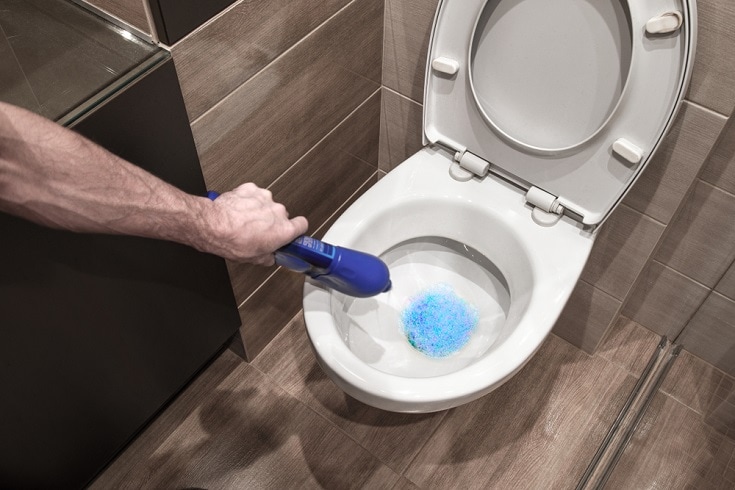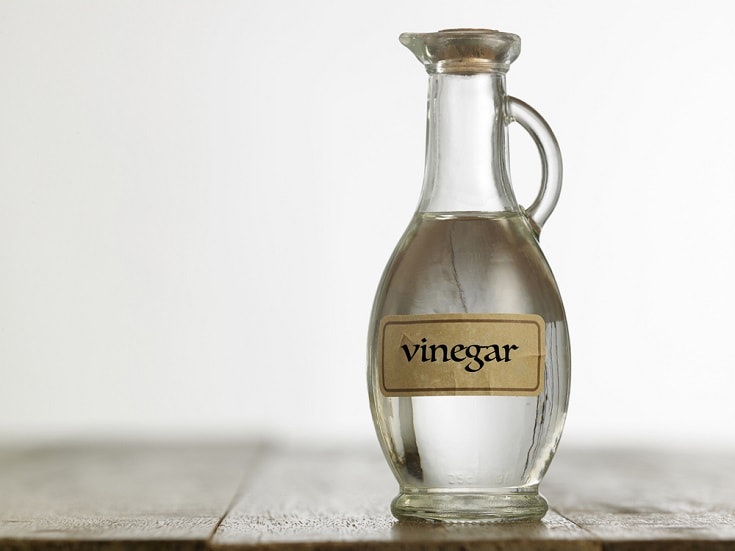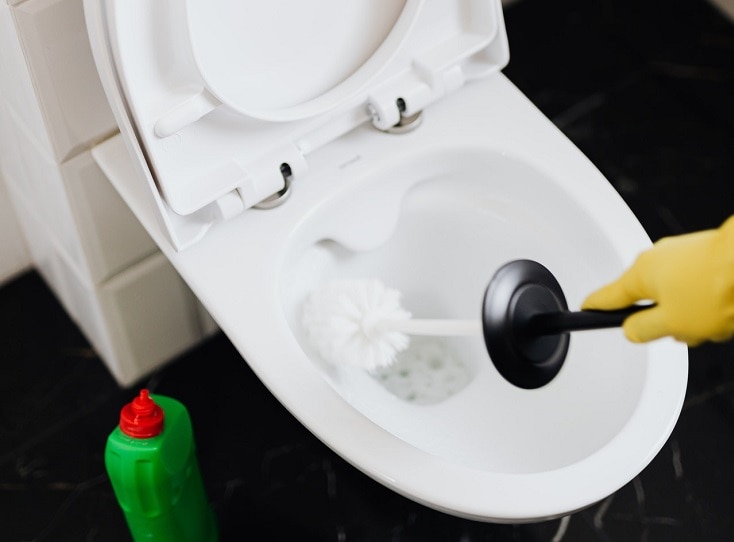How to Unclog a Toilet Without a Plunger – Easy Steps to Follow
-
- Last updated:

The only thing worse than seeing a toilet clog is seeing a toilet clog with no sign of a plunger. Fortunately, rather than declaring the bathroom a no-go zone while you rush out to a DIY store and buy a new plunger, it is possible to unclog a toilet using a number of common household items. You do have gravity on your side, and a little time may be all that’s required to free up the blockage. Failing that, follow the steps below to free up your toilet. You can even modify the technique if you’ve blocked somebody else’s toilet and need a covert cleanup.
What You Need
- Garbage can
- Bucket
- Toilet brush
- Rubber gloves
- Hot water
- Dish soap
- Vinegar
- Baking soda
- Cleaning chemicals
Use Soapy Water

Don’t continue flushing the toilet. It won’t help and it could make things far worse. Ideally, you should stop the bowl from filling up by removing the tank lid and pushing down the flapper. If the water valve is accessible (it is often behind the toilet itself), turn the water off.
Soap can help to break down fat, which binds solids together and is a major cause of clogged toilets. The surface of the soap has much less friction than the surface of the toilet and the blocked solids, too, which means that it can help the blockage slide more easily down the system.
You can prepare the water by adding half a cup of salt before you start.
1. Get The Water Hot
Run the water in the sink or bath and allow it to get hot. The water shouldn’t be boiling. Not only will boiling water prove no more beneficial than hot water, but it could actually damage the porcelain of the toilet. Use tap hot water, fill up a bucket or other container, and pour it down the bowl. This should help break up the clog, and this alone could be enough to free the blockage.
2. Prepare Hot Soapy Water
If hot water alone isn’t enough, use soap. You can use dish soap but any kind of soap should help, even hand soap. This is no time to be stingy with the soap, either, so be liberal with it. The detergent in the soap will break down fat molecules, while the slippery nature of the soap will help encourage the solids down the toilet.

3. Add Water
Once you’ve added soap, give it some time to work and add another bowl of hot water. If the solids have dislodged, they may still be hanging around. Pouring more water will help push the solids down.
Create A Volcano
These next steps will further break down the solids, but the reaction that it causes can be messy, so you should take care to add the vinegar, in the second stage, slowly. This should prevent the liquid in the bowl from spilling over.
4. Add Baking Soda
You will be adding a combination of baking soda and vinegar to the toilet, but one at a time. Start by adding a cup of baking soda to the liquid. Try to ensure that it is well spread around the bowl.
5. Add Vinegar
Once the baking soda has been added, add a cup of vinegar. Pour slowly to prevent the liquid from seeping over the top of the bowl. Let it soak for 20 to 30 minutes and check again, before moving on to the next step.

6. Add A Bath Bomb
If creating your reaction doesn’t do the trick, use a substance that has been created to effervesce in water. Bath bombs do exactly that, and so too do Epsom salts. Drop the bomb or the salts in the toilet and leave them to fizz. The fizzing action could cause some of the clogged solids to become dislodged. Check on the mixture in a few minutes.
7. Break It Up With A Wire Hanger
If nothing else has worked, it is time to take serious action. Grab a wire hanger, extend it into a makeshift rod, and push it down the toilet. Get into and around the solid and push around until it breaks up and separates.
8. Try The Toilet Brush
It isn’t exactly what the toilet brush is designed for, but it is close. Grab the toilet brush and use it to exert some force on the blockage. Try not to twist the head too much, because you may find that you’re left holding a toilet brush handle, but that the blockage has gained a brush head.

Prevent Further Blockage
Once you have worked the blockage free, you should turn the water back on and gradually attempt to flush the toilet. You may be left with some residue in the toilet, but it will pass eventually. You should only put flushable tissue down the toilet. Avoid putting sanitary products, thick tissue, and other non-flushable items down the toilet in the future.
Featured Image Credit: Rolandas Grigaitis, Shutterstock
Contents

